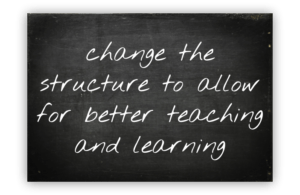
The Context
On February 26th, 2019, Bernie Bleske published this article in Medium, sharing his feelings about the current high school structure. In fact, the title of this post is a direct quote from Bleske’s article.
Backing up further, though, I discovered this article in the April 9th issue of Dan Pink’s email newsletter (check it out here). As with everything Dan Pink shares, it was straightforward and concise, briefly articulating the oddities of the current high school structure, given what we know about productivity, best practices, and the science of time and timing (see his book, When: The Scientific Secrets of Perfect Timing).
My Reflection
In considering Bleske’s article, I recall the importance of seriously considering whether our systems and structures are the best way to achieve our goals. What concerns me about this is the large majority of educators (teachers, admins, etc.) who agree that the current high school system and structure is not ideal and could be significantly improved, yet a very small minority of those like-minded educators are taking serious, thoughtful, and researched action.
Bleske poses the big question, “Why should each student attend every class every day all year long?” then follows it up with his simple solution, “Students should have two long classes each day for six to eight weeks.”
In his newsletter, Dan Pink affirms the benefit of that kind of a shift.
This idea is not new or revolutionary. How many schools or micro schools or sub-schools are doing things like block schedules and multidisciplinary classes and such? Many. And with varying degrees of success (consider this AASA article on research on block scheduling). However, it seems to me that the fallacy that leads to failure in most of these examples can be summed up as, “Merely changing the school bell schedule will not guarantee better student performance.” (Michael D. Rettig, AASA article mentioned above)
So the point, then, is that there are plenty of ways schools can and already are acting on this idea, but the success of such action depends significantly on how teaching and learning practices adapt to the structural change. Let’s be honest. That’s an obvious one. We don’t change the existing structure for the sake of a better structure. We change the structure to allow for better teaching and learning.
Message to Teachers
Assuming anyone reading this post either is or is not teaching in a traditional structure, I would encourage the same thinking either way. The original motivation for my post was that a significant amount of research and common sense agree that the way we teach high school traditionally has some problems.
As the classroom teacher, you can still do something about that, with or without a structural change at your school.
Here’s what you do:
-
- Look for opportunities to collaborate with other teachers/classes/subjects so that students experience some continuity in their learning. (Example: if your English class is doing a persuasive writing project, pair it with a history or government or science class to align the project with the content being learned in those classes.)
- Develop more flexible workflows so that students can engage with content and ideas in more dynamic ways. (Example: organize units by the big ideas and concepts in your course, then present materials and activities and lessons in digital formats that allow students navigate with choice and autonomy, linking the individual resources together with larger projects or tasks or goals.)
- Consider a project based or problem based approach to your content and activities. (Example: develop experiences that connect larger content ideas and skills together with interspersed workshops and mini-lessons to drive explicit instruction and authentic experiences and products to evaluate or demonstrate learning.)
Do SOMEthing
Whatever else you do, find ways to allow students to engage with tasks and ideas in more depth, duration, and flexibility while reducing the number of interruptions and disruptions outside of those intentional breaks that can improve productivity (hint: the need for and timing of such things will significantly vary by student, so consider allowing that kind of thing to be student-driven, as well!).
The raw truth about school structures and schedules is that the best possible format involves combinations of dynamic and flexible structures. That is the unique challenge, but by no means should any educator write it off as impossible simply because it is challenging. We need to be thoughtful, informed, and intentional about how we structure the teaching and learning in both our individual classrooms and our schools on the whole (enter side comment about whole systems here…). Take whatever level of influence you have, and consider how you can make it better. For your students’ sake AND your own.
And while you’re thinking about that, remember that you do not have to (and should never try to) make such changes alone. Others have great successes doing the same things you’re doing, and every decision is better made with more perspectives and examples. That’s where we would love to support you. Our team of coaches will support anyone anywhere. Find out more at cbdconsulting.com/virtualcoach.


